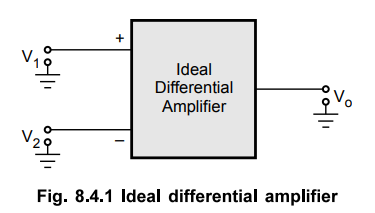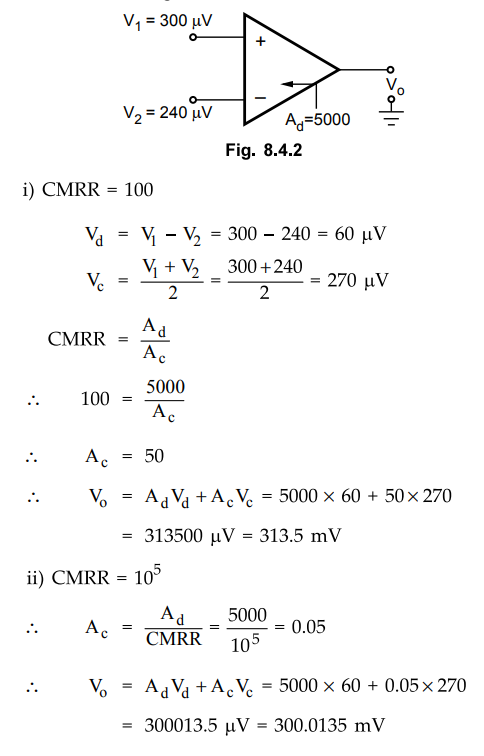Electron Devices and Circuits: Unit IV: Multistage and Differential Amplifiers
Basics of Differential Amplifier
Definition, Features, modes, Formula, Derivation, Solved Example Problems
• The differential amplifier amplifies the difference between two input voltage signals. Hence it is also called difference amplifier.
Basics of Differential Amplifier
AU
: Dec.-09, May-10,12
•
The differential amplifier amplifies the difference between two input voltage
signals. Hence it is also called difference amplifier.
•
Consider an ideal differential amplifier shown in the Fig. 8.4.1.

•
V1 and V2 are the two input signals while Vo is the
single ended output. Each signal is measured with respect to the ground.
•
In an ideal differential amplifier, the output voltage Vo is
proportional to the difference between the two input signals. Hence we can
write,
Vo
∞ (V1 –V2) ...(8.4.1)
1. Differential Gain Ad
•
From the equation (8.4.1) we can write,
Vo
= Ad (V1 –V2)...
(8.4.2)
•
where Ad is the constant of proportionality. The Ad is the gain with
which differential amplifier amplifies the difference between two input
signals. Hence it is called differential gain of the differential amplifier.
Thus, Ad = Differential gain
•
The difference between the two inputs (V1 – V2) is
generally called difference voltage and denoted as Vd
Vo
= Ad Vd
•
Hence the differential gain can be expressed as,
Ad
= Vo / Vd ...(8.4.4)
•
Generally the differential gain is expressed in its decibel (dB) value as,
Ad
= 20 Log 10 (Ad) in dB ... (8.4.5)
2. Common Mode Gain Ac
•
If we apply two input voltages which are equal in all the respects to the
differential amplifier i.e. V1= V2 then ideally the
output voltage
Vo
= (V1 – V2) Ad, must be zero.
•
But the output voltage of the practical differential amplifier not only depends
on the difference voltage but also depends on the average common level of the
two inputs. Such an average level of the two input signals is called common
mode signal denoted as Vc .
Vc
= V1 + V2 / 2 ... (8.4.6)
•
Practically, the differential amplifier produces the output voltage
proportional to such common mode signal, also. The gain with which it amplifies
the common mode signal to produce the output is called common mode gain of the
differential amplifier denoted as Ac.
Vo
= Ac Vc ... (8.4.7)
•
Thus there exists some finite output for V1 = V2 due to
such common mode gain Ac in case of
practical differential amplifiers.
•
So the total output of any differential amplifier can be expressed as,
Vo
= Ad Vd + Ac Vc ... (8.4.8)
•
This shows that if one input is + 25 pV and other is -25 pV then the output of
the amplifier will not be same, with the inputs as 600 pV and 650 pV, though
the difference between the two sets of the inputs is 50 µV.
•
For an ideal differential amplifier, the differential gain Ad must be infinite
while the common mode gain must be zero. This ensures zero output for V1
= V2
•
But due to mismatch in the internal circuitry, there is some output available
for V1 = V2 and gain Ac is not practically zero. The
value of such common mode gain Ac is very very small while the value of the
differential gain Ad is always very large.
•
At this stage, we can define one important parameter of the differential
amplifier known as Common Mode Rejection Ratio (CMRR).
3. Common Mode Rejection Ratio CMRR
When
the same voltage is applied to both the inputs, the differential amplifier is
said to be operated in a common mode configuration. Many disturbance signals,
noise signals appear as a common input signal to both the input terminals of
the differential amplifier. Such a common signal should be rejected by the
differential amplifier.
The
ability of a differential amplifier to reject a common mode signal is expressed
by a ratio called common mode rejection ratio denoted as CMRR.
It
is defined as the ratio of the differential voltage gain Ad to
common mode voltage gain Ac.
CMRR
= ρ = | Ad / Ac |
…. (8.4.9)
•
Ideally the common mode voltage gain is zero, hence the ideal value of CMRR is
infinite.
•
For a practical differential amplifier Ad is large and Ac
is small hence the value of CMRR is also very large.
i)
CMRR = 100
•
Many a times, CMRR is also expressed in dB, as
CMRR
in dB = 20 log | Ad / Ac | dB ... (8.4.10)
•
The output voltage can be expressed interms of CMRR as below :

•
This equation explains that as CMRR is practically very large, though both Vc
and Vd components are present, the output is mostly proportional to the
difference signal only. The common mode component is greatly rejected.
4. Features of Differential Amplifier
•
The various features of a differential amplifier are -
1.
High differential voltage gain.
2.
Low common mode gain.
3.
High CMRR.
4.
Two input terminals.
5.
High input impedance.
6.
Large bandwidth.
7.
Low offset voltages and currents.
8.
Low output impedance.
Ex.
8.4.1 Determine the output voltage of a differential amplifier for the input
voltages of 300 pV and 240 pV. The differential gain of the amplifier is 5000
and the value of the CMRR is i) 100 and ii) 105.
Sol.
:
The differential amplifier is represented as shown in the Fig. 8.4.2.

Key
Point : Ideally Ac must be zero and output should be
only AdVd which is 5000 × 60 × l0-6 i.e. 300
mV. It can be seen that higher the value of CMRR, the output is almost
proportional to the difference voltage Vge rejecting the common mode signal.
Review Questions
1. What is differential amplifier ? Define CMRR. State the
features of differential amplifier.
2. What is a differential amplifier and what are it's common
mode and differential mode inputs ?
AU : May-12, Marks 6
Electron Devices and Circuits: Unit IV: Multistage and Differential Amplifiers : Tag: : Definition, Features, modes, Formula, Derivation, Solved Example Problems - Basics of Differential Amplifier
Related Topics
Related Subjects
Electron Devices and Circuits
EC3301 3rd Semester EEE Dept | 2021 Regulation | 3rd Semester EEE Dept 2021 Regulation
